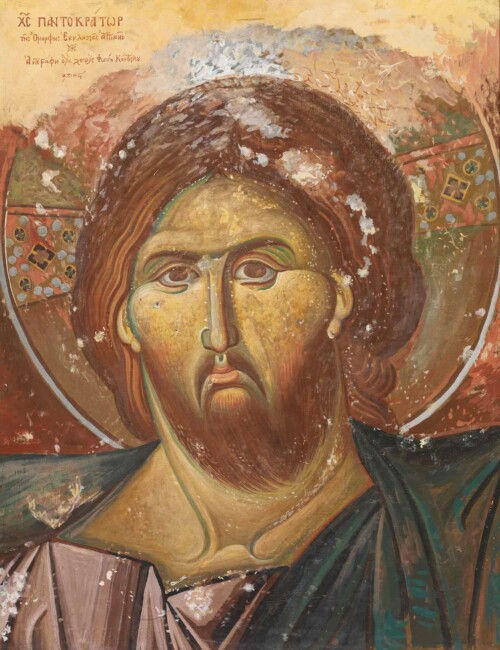| 06 |
Greek, 1895-1965
Christ Pantocrator
oil on hardboard
signed, titled and dated 1956 upper left
inscribed upper left: ΧC ΠΑΝΤΟΚΡΑΤΩΡ, της Όμορφης Εκκλησίας Αττικής, αντεγράφη διά χειρός Φωτίου Κόντογλου, (Byzantine date code for 1956)
84 x 66.5 cm
PROVENANCE
This work was given as a present from the artist to the father of the present owner in the late 1950s.
private collection, Athens
| 12 000 / 18 000 € | |
Omorfokklisia is a 12th century Greek Orthodox church in Galatsi dedicated to Saint George, with an interior decoration of byzantine frescos of unparalleled beauty.
Fotis Kontoglou visits this byzantine monument regularly from the 1920s. In 1943 he was appointed by the then Ministry of Education to conserve the central dome depicting the Christ Pantocrator.
Quoting Kontoglou on his admiration for the Christ Pantocrator of Omorfokklisia:
‘Από τον Παντοκράτορα της Ομορφοεκκλησιάς, θ’αρχίσεις να μαθαίνεις. Πρέπει να πας να τον αντιγράψεις. Δεν θα τα καταφέρεις γιατί δεν αντιγράφεται, τόσο άπιαστο έργο είναι. Και γω δοκίμασα πολλές φορές. Μα έχει ένα μυστήριο, λες και δεν το ’κανε χέρι ανθρώπου. …Μα τούτο το έργο δεν πλησιάζεται. Από 30 χρόνια πηγαίνω εκεί πέρα και Τον βλέπω. Εκείνη η χερούκλα Του είναι σαν όλα μαζί τα χέρια όλου του κόσμου. Σαν να ετοιμάζεται να σου πετάξει το ευαγγέλιο στο κεφάλι! Πολλοί δοκίμασαν να Τον αντιγράψουν μα δεν είναι εύκολο σου λέω! …Είναι ο πιο σπουδαίος Παντοκράτορας σ’ όλη την Ανατολή, μα ποιος το ξέρει αυτό το πράμα…’
Rallis Kopsidis’ pleasant memories of his visits to Omorfokklisia with Kontoglou is apparent in the following quote:
‘Ο Κοντόγλου ζωγράφιζε λιγάκι και για να ξεκουραστεί έβγαινε έξω και καθότανε στις αρχαίες πέτρες και στ’ άγριολούλουδα, που τόσο τα’ αγαπούσε κι έγραφε συχνά γι’ αυτά «τα ταπεινά και τιποτένια». Φανταζότανε κάπου εκεί καθισμένο, στα παλιά τα χρόνια, τον άγνωστο τεχνίτη, τον φερμένο σίγουρα απ’ την Πόλη, που έκανε τούτον τον σπουδαίο Παντοκράτορα κι όμως δεν έβαλε πουθενά τ’ όνομα του. Και καθώς έγερνε ο ήλιος στη δύση του και χρύσωνε τα προσφυγικά σπιτάκια του Περισσού, και τα κυματιστά βουναλάκια ένα γύρο, άνοιγε η καρδιά του κι έψελνε κατανυχτικά, κι η ψαλμωδία ανακατευότανε με τα βελάσματα των προβάτων και των βοσκών τα σφυρίγματα, και μία ειρήνη κύκλωνε την πεδιάδα, σπεπάζοντας τη θαυμαστή εκκλησία με τις άπιαστες κι ακατανόητες ζωγραφιές της.’
Fotis Kontoglou was born in Aivali, Asia Minor in 1895. A year later he lost his father, Nikolaos Apostolellis and the upbringing of him and his siblings was undertaken by his maternal uncle Stefanos Kontoglou, the Abbot of Agia Paraskevi monastery. Perhaps this is the reason he used his maternal surname, as a tribute to his uncle.
The young Kontoglou spends his elementary and high school years in Aivali. Among his closest friends during this period are the future writer, Stratis Doukas and the future ceramic artist, Panos Valsamakis. In 1913 he moved to Athens and enrolled at the School of Fine Arts, only to abandon his studies two years later to travel to major European cities and finally settle down in Paris (However, he finalised his studies in 1933 when he needed the degree to teach at the Athens College).
During his time in Paris, he did not follow any formal education but instead he worked for magazines such as ‘Illustration’ producing ink illustration drawings. Of great importance during this period is his friendship with painter Spyros Papaloukas. While in Paris he writes his masterpiece ‘Pedro Cazas’ which will be first published on his return to Aivali by his childhood friend, the writer Stratis Doukas and would be highly praised by Nikos Kazantzakis, Elias Venezis and Stratis Myrivilis.
In 1919 he returned to his birthplace Aivali and accepts a position as a high school teacher of French and art studies. After the Catastrophe of Smyrna, he moves first as a refugee to Mytilene and then to Athens with the help of authors Vasos Daskalakis and Elli Alexiou where he works as an illustrator for the Encyclopaedic Dictionary Eleftheroudakis.
During this period, he visits Mount Athos where he first comes in contact with Byzantine art, especially painting. The ink drawings he produced during his visit are exhibited first in Mytilene together with Constantinos Maleas and then at the Lyceum Club of Greek Women in Athens (1923).
In 1925 he published the art magazine 'Φιλική Εταιρεία’ together with Dimitris Pikionis and Giannis Kefallinos among others and a year later illustrated the biography of Pavlos Melas who was among the first who organised and participated in the Greek Struggle for Macedonia.
From 1931 he works as an icon conservator at the Byzantine and Christian Museum in Athens. In the years to follow he worked as a conservator at the Corfu Museum, the Coptic Museum in Cairo, Egypt but most importantly from 1936 onwards at Mystras, Peloponnese, where he restored the fresco icons of the church of the Peribleptos Monastery.
In 1932 he decorated his home with fresco decoration with the help of his students Yiannis Tsarouchis and Nikos Engonopoulos. With this work he revived the ‘forgotten' century-old tradition of fresco painting; the fresco is now in the collection of the National Gallery.
Kontoglou was an essential figure of 20th-century Greek art and one of the most important of a group of artists, who are collectively referred to as the ‘Thirties Generation'. They are attributed with having created a renaissance of Greek art in the Interwar years, combining the teachings of the European avant-garde while referencing their Greek heritage. His painting combined elements of Greek art from the classical antiquity, Byzantine art, the work of Domenikos Theotokopoulos and the work of Theofilos Hadjimichael among others. His writings are equally important and revolutionised Greek literature from the 1920s onwards.
His work is found in many public and private collections, notably: the National Gallery of Greece, the Athens Municipality Gallery, the Rhodes Municipality Gallery, the Leventis Gallery, the Teloglion Fine Arts Foundation, the National Bank of Greece Cultural Foundation.
